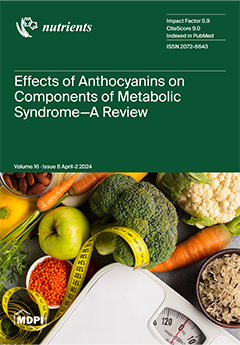This study aimed to investigate the impact of a common non-synonymous gene variant (C>G, rs738409) in patatin-like phospholipase domain-containing 3 (
PNPLA3), leading to the substitution of isoleucine with methionine at position 148 (
PNPLA3-I148M), on susceptibility to nonalcoholic fatty liver
[...] Read more.
This study aimed to investigate the impact of a common non-synonymous gene variant (C>G, rs738409) in patatin-like phospholipase domain-containing 3 (
PNPLA3), leading to the substitution of isoleucine with methionine at position 148 (
PNPLA3-I148M), on susceptibility to nonalcoholic fatty liver disease (NAFLD) and explore potential therapeutic nutritional strategies targeting
PNPLA3. It contributed to understanding sustainable dietary practices for managing NAFLD, recently referred to as metabolic-dysfunction-associated fatty liver. NAFLD had been diagnosed by ultrasound in a metropolitan hospital-based cohort comprising 58,701 middle-aged and older Korean individuals, identifying 2089 NAFLD patients. The interaction between
PNPLA3 and lifestyle factors was investigated. In silico analyses, including virtual screening, molecular docking, and molecular dynamics simulations, were conducted to identify bioactive compounds from foods targeting
PNPLA3(I148M). Subsequent cellular experiments involved treating oleic acid (OA)-exposed HepG2 cells with selected bioactive compounds, both in the absence and presence of compound C (AMPK inhibitor), targeting
PNPLA3 expression. Carriers of the risk allele
PNPLA3_rs738409G showed an increased association with NAFLD risk, particularly with adherence to a plant-based diet, avoidance of a Western-style diet, and smoking. Delphinidin 3-caffeoyl-glucoside, pyranocyanin A, delta-viniferin, kaempferol-7-glucoside, and petunidin 3-rutinoside emerged as potential binders to the active site residues of
PNPLA3, exhibiting a reduction in binding energy. These compounds demonstrated a dose-dependent reduction in intracellular triglyceride and lipid peroxide levels in HepG2 cells, while pretreatment with compound C showed the opposite trend. Kaempferol-7-glucoside and petunidin-3-rutinoside showed potential as inhibitors of
PNPLA3 expression by enhancing AMPK activity, ultimately reducing intrahepatic lipogenesis. In conclusion, there is potential for plant-based diets and specific bioactive compounds to promote sustainable dietary practices to mitigate NAFLD risk, especially in individuals with genetic predispositions.
Full article






